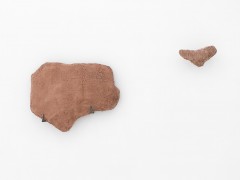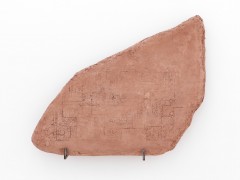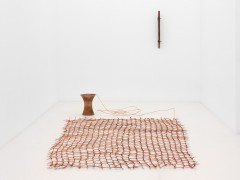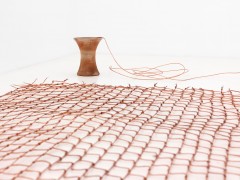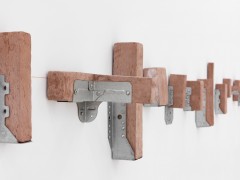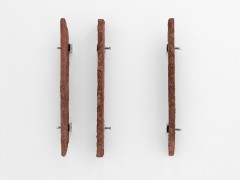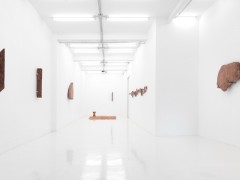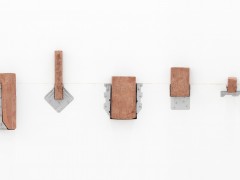Ximena Garrido-Lecca – Toma de la tierra
21.09/2015 – 10.01/2016
Galería Casado Santapau, Madrid, Spain
The Ground Beneath Our Feet on Ximena-Garrido Lecca’s Toma de Tierra
Text by Kit Hammonds, Published on the occasion of the exhibition at Casado Santapau Gallery:
Poor Illapa, reduced from thunderous god ripping the skies apart with anger at our mistakes to being captured in his sister’s jar, tapped of all powers, grounded. There is his spirit trapped the simplest of clay vessels and shorted out by water, all his lightening energy woven out across the floor through copper wires; brought down to earth by a basic circuit designed to protect a building and its inhabitants from his wrath. When we used to give offerings to appease him, sacrifices even, now we hide these protective spells beneath our feet, encased in processed clay and refined metals short-circuiting the universal order of the past in the technological solutions of the present. To provoke the God of Thunder the Inca’s tied up a black dog until it withered from dehydration in the hope that he would take pity and fire his sling to start Inca culture held Illapa in high regard, both to be feared for the tempests he could cause and the saviour from drought by bringing the rain. Rendered in their pantheon in jagged flashes of precious metals, another of Illapa’s names means ‘Radiant Gold’, lightening was glints from his armour. Throughout indigenous American cultures great significance can be inferred in the geometric forms used as decoration on day-to-day items, pots for instance, clothes, and buildings as well as in religious representations. We might conclude that the difference between decoration and enchantment were less distinct than we might perceive it to be today. But such a confluence of patterns between nature, ornamentation and beliefs might still lie there unseen, woven into the fabric of the buildings and objects around us. Explicit devotions transferred to buried wires and circuit boards in the technological spirits in which we have invested our trust.
Ximena Garrido-Lecca’s works thrives on and expose the taut relationship between the cultures of the past and the present, the similitude of instincts to protect and exploit, and the linkages between visuality, materiality and processes. The apparently mundane nature of building materials lies at the infra-thin layer between the two.
In Morfologías de contención (2015) Garrido-Lecca binds together two construction techniques that are, initially an uncomfortable bi-polar ethnography. The metal brackets are a survey of the simple, and surprisingly fragile looking joints used in the wooden construction, particularly for floor and roofs. Not insignificantly they are called strong ties, evoking their own poetry. Each work contains a simple clay brick, a parallel construction method, but in a perfect fit to one another. Their mutual similarities and individual differences fit not only the conceptual art forms of aesthetic order and series, but also principles of evolutionary theory in the illustrations of ‘primative’ bodies of tribes or criminals in the erroneous ethnographic tendencies of 18th and 19th century logic. Arranged in all their variations, theses basic building devices suddenly seem fragile as individual lives. Can we really put our trust in these folds of metal to support us? Or should we be offering some kind of devotion to ensure they keep us secure?
The clay bricks used to construct construct the pyramids or ’huacas’ in different parts of Lima are known to be produced laid by many people as a devotional act rather than as a simple act of construction. It was the spiritual duty of all subjects in the Peruvian Empires to pay homage to the gods to efface their wrath. This ‘Payment to the Earth’ could be enacted as a ceremony to Pachamama, or, in other ways through the production and laying of bricks in the on-going construction of a pyramid.
The physical construction of a pyramid as much as its spiritual one is inherently based on security. It is, in effect, the best way to build a stable tower without any real engineering. Pyramids are in essence mounds of stones that following the natural order for their stability. But in the case of the Peruvian pyramids their builders still had to contend with the wrath of the earth, earthquakes that frequent the geologically unstable west coast of South America. And so the arrangement of the bricks in columns and then rows allows for some movement in the structure of the building, absorbing the energy that might otherwise shake any building to the ground.
This structural engineering was developed and all but forgotten post-colonisation. While edifices got bigger, taller, they became more and more solidly built to European standards, only to prove more deadly if an earthquake hit. It is only in the modern era that buildings were once again engineered to withstand seismic shocks, it has taken centuries to rediscover this. Of course, for the indigenous people the knowledge of how to build was a sacred geometry in itself, not a scientific solution – a South American equivalent to the European Masons whose engineering was informed as much by the mysticism of the illuminati as it was by what we might now call logic. To build seems to be an act of faith.
Garrido-Lecca’s current practice operates in the spaces of a sacred geometry that interweaves the ancient and the modern forms of security, the comforts that are large investments against the, ultimately, uncontrollable forces of nature. While these are disastrous, of course, they are statistically less likely than the dangers we present ourselves with when simply crossing the road. Large-scale destruction seems to tap into subconscious fears, and we mitigate against them in whatever way we can, even against the hard facts. Take, for example, the investment in security cameras whose systems Garrido-Lecca has inscribed on fragments of walls in her Diagramas de seguridad series (2015). Each ‘fragment’ seems to have been removed from an historic site, and displayed like an artefacts in an anthropological museum, a space of constant surveillance. Rendering visible is not the same as protecting any more than being hidden ensures safety.
There is undoubtedly a need to feel secure, just as there is a need to feel free. And security is the defence against the unseen, the outsider. In this way we are all ‘othered’. While the colonised peoples, the ‘indiginous’, represented access to a ‘savage’ nature, there was never really a threat that those forces might usurp the technological forces of the west. In this sense, taking a risk was moderated by technologies that allowed for exploration, with the aim to ‘taming’ nature of one kind or another, harnessing its potential. As much as atomic technologies (both war-faring and energy-producing) have shown us that the harness of the extremes of natural energies may not produce the simple clean effects that we had hoped, so in parallel the accelerated modernisation of previous colonial centers now puts the former west under pressure. We see it physically and culturally. Although Garrido-Lecca is wary of drawing parallels between her security diagrams and Syrian stone tablets for fear of limiting them to a context in which she is not so familiar, the influx of refugees into Europe and beyond has certainly increased the sense of a siege mentality within the traditional world centers. The rise of Chinese, Indian, Brazilian, Nigerian and indeed Peruvian economic power has made real the possibility that these ‘indiginies’ may actually possess the knowledge and abilities to supplant power through being able to play the same game, by gaining access the same technologies. And so these works tap into a broader concern, an affective disquiet that the world orders are more fragile than they might be leaving us with constant questions: What kind of security do we through up around us? Is there any more sense in the webs of copper that weave through the streets and under the roads into our houses, than there is in the symbols carved for protection against ancient gods? Is it possible to reconcile the two? Garrido-Lecca gives shape and form to this precarious ground on which we place our trust.


 Home
Home
